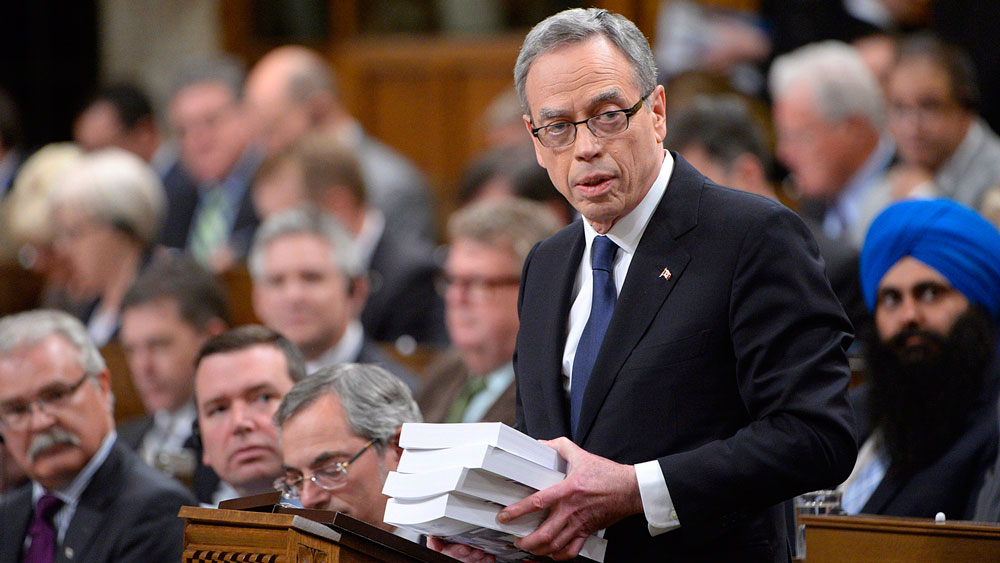
A budget of targets
Federal budgets are prime opportunities for governments to dole out tax breaks and other treats designed to appeal to different categories of potential voters, from small-business owners to seniors and immigrant communities. Those targeted offerings become more important in an election year. With Canadians set to go to the polls by October at the latest, The Globe and Mail looked at seven key constituencies the Conservatives are looking to court with this year’s fiscal plan.
SMALL BUSINESS OWNERS
 Why: Small-business owners are a natural constituency for the Conservatives. The tax reduction also moves in on territory the Opposition NDP has already tried to stake out: New Democratic Leader Thomas Mulcair announced in January his party would implement a small-business tax cut if elected.
Why: Small-business owners are a natural constituency for the Conservatives. The tax reduction also moves in on territory the Opposition NDP has already tried to stake out: New Democratic Leader Thomas Mulcair announced in January his party would implement a small-business tax cut if elected.
The number:
Cut the small-business tax rate from 11 per cent to 9 per cent by 2019.
What and how:
The budget proposes to reduce the small-business tax rate by 0.5 per cent for each of the next four years, eventually bringing it down from 11 per cent to 9 per cent. The lower tax rate applies to the first $500,000 in qualifying income. The budget also proposes to exempt farmers and fishers from up to $1-million in lifetime capital gains and to allow manufacturers to write off capital investments at a faster rate than they could previously.
How it might fall short:
Reducing the small-business tax rate gives business owners a greater incentive to keep their enterprises small and avoid graduating to a higher tax rate. They may do that by creating additional companies, rather than growing into a single, larger venture. In addition, research from University of Calgary economist Jack Mintz suggests that a majority of small-business tax deductions benefit households with income of more than $150,000.
Kim Mackrael
COMMUTERS
 Why: The Conservatives will win or lose the election in suburban Canada, especially around big cities such as Toronto and Vancouver.
Why: The Conservatives will win or lose the election in suburban Canada, especially around big cities such as Toronto and Vancouver.
The numbers:
$750-million over two years, starting in 2017-18, and $1-billion a year thereafter.
What and how:
Gridlock is at the top of the list of grievances for those who live in family-oriented regions around Canada’s big cities and must commute in bumper-to-bumper traffic. It’s bad for the personal life of the commuters, for productivity and for the environment. And Canadian municipalities have been asking for money for public-transit infrastructure for many years. The government is proposing to create a public transit fund that would invest in transit infrastructure such as light rail, subways and bus routes. The aim is to increase ridership and lower congestion on the roads. Money from the fund would go to projects in which private interests are willing to invest – in other words, public-private partnerships. The federal government would also consider paying its portion of a transit project over 20 or 30 years instead of providing the total contribution up front. Details of the program will be released later this year, possibly during the election campaign.
How it might fall short:
Some say it’s not enough. Ontario Finance Minister Charles Sousa, for instance, said his province needs more than what is being offered for infrastructure such as for public transit in the Greater Toronto Area. Plus, the requirement that there must be a public-private partnership could hobble municipalities where no private investors can be found. But Brad Woodside, the president of the Federation of Canadian Municipalities, says most municipal transit projects entail the private sector in some capacity.
Gloria Galloway
John Ibbitson on how Harper's 'old-fashioned' values shaped the 2015 budget
IMMIGRANTS
 Why: The Conservatives have aggressively targeted immigrant communities, winning over many people who had previously voted for the Liberal Party.
Why: The Conservatives have aggressively targeted immigrant communities, winning over many people who had previously voted for the Liberal Party.
The Number:
$6-million over five years to improve remittance services for people who want to send money abroad.
What and how:
The budget earmarks funding to establish a website to help people compare the fees that are charged by different service providers, among other initiatives.
How it might fall short:
Banks and remittance agencies make money on both the flat-rate fees they charge and exchange-rate premiums. While fees are relatively easy to compare, it’s much more difficult to figure out how much extra is being tacked on to the exchange rate. A private member’s bill, introduced recently by NDP MP Peggy Nash, would go further, by capping remittance fees at 5 per cent of the amount being transferred and preventing banks and agencies from charging more than the standard exchange rate.
Kim Mackrael
SENIOR CITIZENS
 Why: Seniors reliably arrive at polling stations on election day. And they tend to vote Conservative.
Why: Seniors reliably arrive at polling stations on election day. And they tend to vote Conservative.
The number:
$235-million in 2015-16 for three changes directed to seniors.
What and how:
The government will cut the amount that seniors must withdraw annually from their registered retirement income funds (RRIFs), provide tax relief when they renovate their homes to make them more senior-friendly and hike the amount that can be contributed annually to a tax-free savings account (TFSA).
Existing rules around RRIFs demand that seniors withdraw at least 7.38 per cent of their registered retirement savings in the year they turn 71. That increases annually until they turn 94, when they must withdraw 20 per cent annually from what is left. The new minimum RRIF withdrawals would range from 5.28 per cent at age 71 to 20 per cent at age 95 and above. This reduces the possibility that seniors will outlive their life savings.
The annual contribution limits to TFSAs would be increased from $5,500 to $10,000.
The new Home Accessibility Tax Credit would provide an income-tax credit of 15 per cent on up to $10,000 of eligible home renovations such as the installation of wheelchair ramps, walk-in bathtubs and grab bars.
How it might fall short:
Critics say doubling TFSA contribution limits will primarily benefit the wealthy – the government shows figures to argue that is not true – and burden future governments by reducing revenues. And Herb John of the National Pensioners Federation says his organization was looking for improvements to the Canada Pension Plan, the Old Age Security Pension and the Guaranteed Income Supplement, but they were not in this budget.
Gloria Galloway
Veterans
 Why: They make up a constituency the Conservatives can normally count in their corner. But shortcomings in the compensation package for disabled new vets left many disgruntled and created a public-relations issue for the government.
Why: They make up a constituency the Conservatives can normally count in their corner. But shortcomings in the compensation package for disabled new vets left many disgruntled and created a public-relations issue for the government.
The number:
An additional $200-million in 2015-16
What and how:
Veterans Affairs Minister Erin O’Toole, who was appointed to the portfolio in January amid rising tensions with vets, has made a series of announcements over the past two months that are costed in this budget. They include a guaranteed retirement income for severely disabled veterans, greater access to monthly payments under the permanent impairment allowance and money to help family caregivers take a break. In addition, there is better income support for injured part-time reservists and payments of $70,000 to compensate for severe and traumatic injuries or diseases.
Also, the government is promising, after years of trimming staff at Veterans Affairs, to increase the number of caseworkers and disability-claims adjudicators. That should help to address criticisms by the federal Auditor-General who said in a report last year that many veterans were waiting months, and sometimes years, to get the mental-health treatment they needed.
How it might fall short:
Although the individual announcements combine to create a significant pot of extra money for injured and disabled veterans, several of the new measures go only part of the way to meeting the demands of former military members and their advocates.
Gloria Galloway
CAREGIVERS
 Why: Boomers are the largest segment of the population, with the most number of votes.
Why: Boomers are the largest segment of the population, with the most number of votes.
The number:
Up to $37-million annually.
What and how:
The government says, starting in January, 2016, it will extend the compassionate-care benefits it offers through the employment insurance plan from six weeks to six months to allow working Canadians to take more time away from their jobs to care for a gravely ill family member. This is aimed primarily at people in the so-called sandwich generation – the middle-aged Canadians who suddenly find themselves providing care to a parent, grandparent or a spouse – or those with a dying child.
The government says it has heard from stakeholders that the existing parameters of the program do not reflect the financial realities and hardships associated with caring for someone who is at the end of their life. Serious diseases often require more than six weeks of care. The benefit provides a maximum of $524 a week to those who can verify with a doctor’s certificate that their loved one is at significant risk of dying within the next six months.
How it might fall short:
It is difficult to see the down side to this measure and there is unlikely to be much criticism. The cost is relatively low and the need, when it arises, is obvious. Gabriel Miller of the Canadian Cancer Society said it was a big step in a positive direction.
Gloria Galloway
THE SUBURBAN FAMILY
 Why: The government sees families with children as a key policy focus and they have been a consistent target of the Conservatives since the party took office in 2006.
Why: The government sees families with children as a key policy focus and they have been a consistent target of the Conservatives since the party took office in 2006.
The number:
Universal child-care benefits increased to $160 a month for children under age six and $60 a month for children between the ages of six and 17, beginning in January, 2015.
What and how:
Most of the initiatives targeting families with children were announced in October, 2014. Those measures include plans to increase universal child-care benefits as well as the maximum amount of child-care expenses that are tax-deductible. Families with children under the age of 18 were also eligible for a new, non-refundable tax credit of up to $2,000 – also known as income splitting – starting with the 2014 taxation year. In addition, the government doubled the maximum amount that can be claimed through the children’s fitness tax credit, bringing the total to $1,000 in the 2014 tax year, and will make the credit refundable starting in the 2015 tax year.
Other initiatives target families with older children, including a reduction in the parental contribution needed for the Canada Student Loans Program. The budget also expands grants that are currently available for low- and middle-income students to include those enrolled in shorter programs.
How it might fall short:
The government’s income-splitting plan offers the greatest benefits to high-income households with one spouse who doesn’t work, leading to criticism that lower-income families will have less to gain. The budget also does not include a tax credit for adult fitness as some had anticipated. Instead, the government says it will establish an expert panel to study the potential scope of an adult fitness tax credit to inform future decisions.
Kim Mackrael


